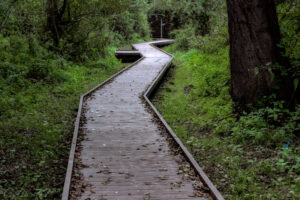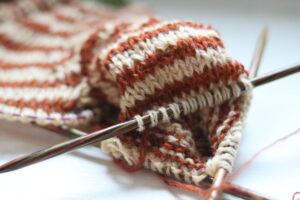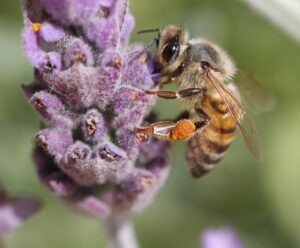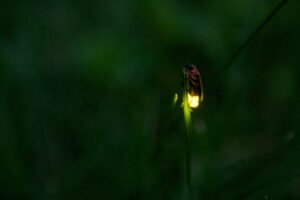Posts by Kelsey Allagood
WU community, I have a confession:
I’ve been in a “reading slump” for the last decade.
By “reading slump,” I mean that the novels I’ve finished belong to a highly exclusive club. I’ve accidentally pivoted toward nonfiction—Wendell Berry and Erich Fromm alongside Masha Gessen and bell hooks. Nothing wrong with that, of course, but sometimes I miss that sneak-a-book-under-the-covers feeling of a good, juicy novel.
So, what happened? Too much screen time killing my attention span (I mean, yes)? I’m getting old and now everything that’s not aligned with my personal preferences is what’s wrong with Kids These Days (…also likely)?
There are lots of possible causes, but only one has really stuck out to me: I don’t like it when books feel too much like a bad tour guide.
A bad tour guide? What?
When I talk to newish writers about how to “show, don’t tell,” I often use the metaphor of a guide taking a group on a nature walk. In this metaphor, the writer is the guide. A good guide will keep the pace of the group moving forward and on track without overexplaining or underexplaining. Every so often, they may stop or slow the pace of the walk to point out points of interest and share their specialized information (“Look at this cool bug!”).
The readers are the tour group, trusting the guide to ferry them responsibly from point A to point B.
When a nature walk breaks down, it might be for a few reasons: the guide used their time irresponsibly, meandering too much in the beginning and rushing the end; the guide lost control of the tour group due to carelessness or simply being boring, leading the group to try to guide themselves through the wilderness; or the tour guide marches the group through the underbrush like a drill instructor, pointing out everything but stopping nowhere.
Increasingly, I’ve been noticing a trend in contemporary novels toward the overly aggressive tour guide.
I pretty much feel like I’m being dragged along by the hair by a book while it yells, “LOOK AT THE PLOT. THIS IS THE PLOT!”
The moment of realization
I came to this conclusion while reading an adult fantasy novel published in 2022 by a Big 5 publisher. I actually finished the book, even though it gave me aggressive tour guide vibes, because the prose was so good I could mostly overlook how I felt like I was being breathlessly yanked along a single track, and that single track was the plot, and no we don’t have time to stop and breathe and briefly explore this fun little thing that maybe doesn’t push the plot forward much but adds some flavor to our journey.
What stuck out most was that that I viewed this book as extremely fast-paced to the detriment of the story. But when I went to record the book in my tracking app, I saw that 68% of people who had rated the book thought it was “medium” or “slow” paced.
I stared at this data for a while, wondering what planet I was living on.
It’s not content, it’s art
To me, this pattern—which, admittedly, I have noticed from a small sample size—feels like the content-ification (this is a word) of novels. Over the last decade or more, art of all […]
Read MoreThat’s right, folks: It’s time for another installment of Kelsey Drawing Lessons About Writing From Her Other Hobbies! Fortunately or unfortunately for you, I’m running out of hobbies from which to draw writing-related lessons. Birdwatching might be the only one left, actually. Though I can probably find some similarities between writing and birds. Stay tuned.
I taught myself to knit during a two-week visit home during college. My parents lived in an isolated rural area, where there was little to do for someone under 21 whose friends lived far away besides hang out in the local Wal-Mart parking lot.
At some point, my mother had picked up a how-to book on knitting and crocheting, as well as some needles, hooks, and yarn. Bored out of my mind one day, I decided to start teaching myself how to crochet. Knitting had become popular among my hipster peers, and I’d overheard them on more than one occasion talk about how they had learned crochet first, as it was far easier to pick up. So, I picked up a hook and yarn, and consulted the book.
Reader, I Could Not Get It.
Crochet felt like Black Magic to me. Even with the diagrams, the process of making the first row—called the “starting chain,” which you must have to start actually crocheting—made absolutely no sense to me. I asked my mom, but she hadn’t gotten very far into the book. I think I inherited my “I must be good at something immediately or else I get frustrated and quit” trait from her.
Nowadays I’d go search YouTube for tutorials, but the satellite internet at my parents’ house made watching videos almost impossible. I remember being required by my college to watch a video about the dangers of binge drinking to be allowed to sign up for classes, and it took about an hour to load a ten-minute video.
So, I put the crochet hook down.
A few days later, bored again, I picked up the knitting needles and opened the book again.
It clicked. For whatever reason, working with my brain—instead of against it—helped me make progress (this is in bold because it’s a Writing Lesson, you see).
I managed to churn out a couple of wonky potholders, and I took the needles, yarn, and other accoutrements back to college with me, where I soon ventured into shawls, scarves, and even beanies.
What I never picked up—and still haven’t mastered, not even years later—is how to “tink.” That’s “knit,” but backwards, and it’s the process of undoing your knitting, usually because you made a mistake. And as anyone who’s ever tried anything will tell you, mistakes happen, no matter how practiced you are at a craft.
And because I couldn’t tink, I couldn’t fix my mistakes, which of course were many. It became the starting chain all over again: even with better internet access, my brain simply couldn’t parse how to knit backwards.
Over time, I came up with a couple of hacks to try to get around this issue. Using fuzzier yarn in variegated colors allowed me to hide some mistakes, such as dropped stitches or wonky patterning. Having index cards beside me so I could write down exactly what row I had just finished helped keep me on track.
But if I […]
Read MoreHappy New Year, WU community! A slight content warning that this post mentions some heavy topics, though not in too much detail.
I’m reading an essay by Refaat Alareer, a Palestinian poet and professor, called “Gaza Asks: When Shall This Pass?” In his essay, Refaat recounts the times he told stories to his young children during the war of 2008-09 while sheltering them in the part of his house least likely to be hit by a stray missile.
“My stories were both an end and a means,” he writes. “As I told stories to my children to distract, soothe, and educate them, I felt very close to my mother and to my grandparents.” The stories he told his children were the same stories his own mother told him, or variations on them; he sometimes starred his children as the “heroes or saviors.”
For a while, when I was a young child plagued by insomnia and anxiety, my own mother invented stories for me before bed. I was usually the hero or savior of these tales, often saving my classmates or talking animal friends from danger. As I grew into a young person still plagued by insomnia and anxiety, I began to tell myself stories to get to sleep. These stories kept me from ruminating on distressing thoughts and turning every creak or gust of wind into an intruder coming to hurt me. They kept me safe.
Storytelling is an act of resistance. For child-me, far removed from the threat of stray missiles striking my bedroom, the stories helped me resist a different sort of fear.
I chose to say “storytelling” over “writing”—even though we are Writer Unboxed—because oral storytelling is equally a form of resistance. I’m thinking of the drifters of Fahrenheit 451 memorizing books to thwart the book-burning firemen, of course, but also oral storytelling evolving in tandem with human language, long before the written word; I’m thinking of the preservation of oral storytelling traditions among Indigenous cultures despite outside pressure to commit them to paper. Oral and written stories each have unique positive qualities. They are also complementary, and both are valid modalities.
We often think of resistance in its bodily form: taking up arms, throwing stones at oncoming tanks, sitting at lunch counters, chaining ourselves to trees marked for destruction. We might also consider famous works of resistance literature, such as The Grapes of Wrath, Maus, or Beloved.
Sometimes the act of speaking alone is resistance: a parent telling stories to comfort their children, or an Indigenous person speaking their own language.
While she is not always presented as a resistance fighter, Anne Frank’s diary is probably one of the greatest examples of writing as an act of resistance. Through its fame, The Diary of a Young Girl by itself preserved the memory of one of the many families partially or completely annihilated during the Holocaust.
And I don’t want to erase Anne’s own conscious resistance: in 1944, she started rewriting her diary, preparing it for publication in response to the Dutch government-in-exile’s request that individuals document the occupation. Fifteen-year-old Anne knew exactly what she was doing: standing up to attempted elimination by asserting unequivocally that she had lived.
At its most basic, we could […]
Read MoreA few years ago—almost three! My god, what is time?—my very first post on Writer Unboxed argued against cynicism disguised as reality and in favor of imagining better things through story.
I’d like to add a little something to that message.
To be clear, when I’m talking about cynicism, I’m not talking about stories with dark themes or tragic endings, both of which have a place in literary canon. By cynicism, I mean stories that are told for shock value, to be “edgy” or “realistic” (there are not enough air quotes in the world for that last one)—in essence, narratives that are told with nihilism solely for the sake of making a point to the reader, rather than the sake of the story.
Cynicism can, at times, be easier than imagining something new. It can be protective. If you’re an anxiety sufferer like I am, you know that anxiety is miserable, but it can also feel like a shield: if I think about the worst things that could happen, then I’ll be prepared, and it won’t hurt as much when bad things do happen. That’s of course not how things work (sorry, fellow anxiety-havers), but our brains are quite adept at coming up with illogical ways of protecting us.
But cynicism can protect us in other ways. In particular, in places with greater oppression, expressing an idea for how the world might be improved can draw negative attention from powers that are invested in the status quo.
Dictatorships often begin and are sustained by attacks on art, Toni Morrison argues in her essay “No Place for Self-Pity, No Room for Fear” (published in The Nation in 2015):
the censorship and book-burning of unpoliced prose, the harassment and detention of painters, journalists, poets, playwrights, novelists, essayists. This is the first step of a despot whose instinctive acts of malevolence are not simply mindless or evil; they are also perceptive. Such despots know very well that their strategy of repression will allow the real tools of oppressive power to flourish.
Less seriously, cynicism can protect us from being viewed as weak, naïve, or idealistic—all typically assigned as negative traits. I want to acknowledge that it can be hard, uncomfortable, and even frightening to tell some stories. But that, of course, makes it even more important that they are told.
Read MoreSince the last time we spoke, I drafted another book.
Before you applaud, like the title of this post says, it is a zero draft, so it is very, very far from something fit for human consumption. As for what the heck “zero draft” even means, and how I did it in six weeks, read on:
What is a zero draft?
Like the name implies, the zero draft is a sort of pre-first draft. It is the draft before the Draft. Sometimes it can feel like we writers have mythologized the first draft by trying so hard to un-mythologize it. “Get it all down,” “You can’t outsmart the first draft,” “Close the door,” “Write for yourself,” “Give yourself permission to suck”—I get the intent, but I’ve found myself in the midst of first drafts wondering if I’m not caring hard enough. As I write, there’s a voice in the back of my mind asking, Am I still caring too much? Can I not care even more? Please, tell me how to care less about my book.
The thing is: I do care. I can’t not care about how my drafts sound. I recognize that rewriting is an inevitability, perfection is an illusion, and first drafts are always the worst, and yet—
I like the process of writing. I care less about having written. I like crafting prose, making sentences sing, and finding the exact right word for the feeling I’m trying to express. I’m not unique in that—I’m sure most of us like this part!—but I’ve finally accepted that I am unable to turn that part of my brain off to write a bad first draft.
But, of course, books are fickle things. Crafting prose takes a lot of time. There’s nothing quite as soul-crushing as spending a full day perfecting the flow of one paragraph only to have to scrap the whole thing in the next draft because that part of the book became irrelevant.
I recognized that I needed a middle ground, something that could trigger that part of my brain that said, “It’s ok to suck here. It’s ok to figure out what the heck’s going on in this book before you ever try to write a nice-sounding sentence.”
Enter: zero drafting.
Finally, a definition.
Zero drafting is the barest bones of a draft. It is a several steps more detailed than an outline, but less fleshed out than a first draft. There’s no set length for it: I’ve seen anywhere from 10 pages to 30,000 words recommended for zero drafting. Mine ended up being about 10,000 words. The right length for your zero draft is entirely what works best for you.
In short, in my version of zero drafting, I took my outline (more on that in a moment) and turned it into scenes, using simple language to describe what happens in each scene. It is stage directions with hardly any dialogue.
Here’s an example from the zero draft of the book:
Someone jerks his head toward the monsters, impatient.
Brigid makes a threatening gesture. Calm the hell down.
The monsters gather and begin to feed. Others in the gang wince and retch. Brigid doesn’t.
She gestures for them to attack.
She takes the lead and shows herself an expert fighter. Her team works well together, and they take […]
Read MoreEvery week, a writer friend and I meet over Discord to discuss our writing progress and to set new goals for the week ahead.
And for about 12 weeks at the end of last year and the beginning of this one, our check-ins began with one question:
“So, how has Julia Cameron personally victimized you this week?”
Julia Cameron isn’t anyone either of us know personally, nor is she trying to specifically victimize us (probably). She is the author of The Artist’s Way: A Spiritual Path to Higher Creativity, a self-guided course that’s been a classic among creatives since it first came out in 1992. A lot of you have probably done the course or parts of it, or at least heard of the concept of “morning pages”—the daily practice of writing three pages of longhand, stream-of-consciousness thoughts—that originated with it.
For those who don’t know, The Artist’s Way aims to help people overcome creative blockages, whether it’s in specific artistic projects, career paths, or life. And despite, as far as I know, not having a background in psychology, Julia (we started calling her Julia in our check-ins as well, usually to say, “Damn it, Julia!”) really nails some of the root psychological causes of creative blockages.
Getting out of my own way
Getting to this point required overcoming a few of my own internal hurdles.
“I don’t feel blocked,” I thought, ignoring the fact that I do not have a published book under my name in no small part because even when I finish a book, it is not “good enough,” I know I can “do better,” so what if I just “rewrite it a little,” (repeat ad nauseum).
But after two separate friends—within a few weeks of each other!—highly recommended the book to me, I bought a used copy, recruited another writer friend to be my accountability buddy, and jumped in.
I didn’t really know what to expect when I started, figuring it was best to go in with as much of an open mind is possible.
I’m wary of popular self-help books in general, and warier still of self-help books with the word “spirituality” in the title. My friends had assured me that the “spiritual” part of the Spiritual Path was open-ended, less about “spirituality” as it’s commonly understood and more about each person creating their own understanding of their personal creative flow.
As a skeptic, I find that these books often just don’t vibe with the way I see he world. And there was definitely some creative (hah) thinking I had to do to get around some of Cameron’s language. But overall it’s obvious that while Cameron may have a certain belief system of her own, she’s at least trying to create frameworks of thought that are accessible to everyone.
So here are a few things I learned about myself during the process of doing this course, and three more things I’ve changed about the way I approach creativity.
Things I Learned
1. I don’t let myself play.
This was a tough one to accept.
“Of course I know how to play,” I would think to myself. “I do things that are fun!”
Yeah, that’s not what that means.
“Play” in this case is the doing of things that bring us joy, wherein joy is the only and ultimate goal. Putting […]
Read MoreI almost titled this post “What We Talk about When We Talk about Talking,” but it looked bad as a header.
As a not-professional editor who nonetheless gets to edit my friends’ writing, one of the most common questions I get is, “Does the dialogue sound natural?”
And often, because my friends are talented, the answer is most definitely “yes.”
But is “natural” really the highest form of dialogue? We all want our dialogue to sound natural, as opposed to stilted, but dialogue can sound natural and still be missing that extra spark that takes it from “good dialogue” to “oh my god, Becky, I will remember this line for the rest of my days” dialogue.
As I looked up some online sources on writing good dialogue that I could share with my friends, I found that many of them repeated the same advice. Most of the focus was on what characters should say, or else how they should say it: dialogue must move the plot forward, dialogue must reveal something about the relationship between characters, dialogue should sound natural but not too natural, dialogue should be unique to characters’ backgrounds, don’t pad your dialogue with unnecessary small talk, avoid greetings and soliloquies and goodbyes, have characters be indirect.
These are great pieces of advice, but even if you follow them to the letter, your dialogue still may come out sounding wooden.
I’d like to offer a third way to look at dialogue, and ironically, it’s through what isn’t said.
“But Kelsey,” you say, “that sounds like ‘show, don’t tell,’ which is the oldest advice in the book.”
Yes. I mean, it is basically that, but “show, don’t tell” was usually framed around character actions, not dialogue: e.g., “Sally was mad” versus “Sally stomped to her room and slammed the door.” Similarly, there is plenty of advice out there that recommends having characters be indirect in their speech (one of my favorite tactics), but that’s not what I mean here, either.
The classic example of the art of the unsaid—and it’s a classic for a reason—is Hemingway’s “Hills Like White Elephants.” In this story, the topic of discussion between the man and woman is never made explicit; readers must complete the story by insinuating the couple’s meaning from what they say and how they speak. But if we take our analysis even further, we can see that part of what makes this story so compelling is not just because of what was left unsaid, but how it was left unsaid.
Take this passage, for example:
“Well,” the man said, “if you don’t want to you don’t have to. I wouldn’t have you do it if you didn’t want to. But I know it’s perfectly simple.”
“And you really want to?”
“I think it’s the best thing to do. But I don’t want you to do it if you really don’t want to.”
“And if I do it you’ll be happy and things will be like they were and you’ll love me?”
“I love you now. You know I love you.”
“I know. But if I do it, then it will be nice again if I say things are like white elephants, and you’ll like it?”
“I’ll love it. I love it now but I just can’t think […]
Read MoreIt’s spooky season, my friends, and in my household that means three things: apple cider, pumpkin bread, and horror movies. But even if your taste in seasonal flicks is more Halloweentown than Train to Busan, there’s still a lot that we writers—of all genres—can learn from a good horror story.
Despite being a professed horror fan, I’d never seen The Blair Witch Project until this month. I went in with moderate expectations: it’s rated 3.4 out of 5 stars on Google, and 6.5 out of 10 on IMDb, which are solidly mediocre popular ratings. Most horror films don’t affect me beyond the film itself, meaning I can walk out of the theater (or more often these days, away from my couch) and into a dark room without jumping at every little noise.
When Blair Witch ended, though, and it was time to ready myself for bed, I had to make my husband stand in the bathroom with me while I brushed my teeth so I wouldn’t be alone.
What the heck was it that made this film—a 90-minute story of people getting lost in the woods, in which there’s hardly any blood, and we never even see a glimpse of the monster—the one that spooked me to the core?
Found footage movies like Blair Witch have gotten popular in part because they feel more “real.” I’m old enough to remember people having earnest discussions when the film came out over whether it was a true story. But I knew it was more than that. Not only did the found footage style of the film make it feel like something that could realistically happen to me: it made me think about what I would have done in a similar situation. What would I do if I got lost in a wooded area without a map? What would I do if I got lost in a wooded area without a map and I was with someone I didn’t know well, and whom I didn’t trust to keep their head in an emergency?
That train of thought alone was enough to get me feeling anxious.
Most horror films come with an element of the supernatural that removes the characters’ actions from my own day-to-day. What would I do if my train was suddenly filled with zombies? It’s a fun thought experiment, but I don’t know because it’s a scenario that’s highly unlikely to occur (though I’ve lived through enough unprecedented events that I’m not about to tempt fate by declaring in public that a zombie apocalypse cannot happen).
Getting lost in the woods, though? That’s something that definitely could happen. Blair Witch had the right combination of realness (the found footage style) and believability (I could get lost in woods that look just like those woods) to tap right into a well of fear at my center.
And at its broadest, the horror genre is about the emotion of fear. As a driver of human activity, fear is right up there with power, desire, and social acceptance. That means that it’s also an excellent driver of our characters’ actions—particularly when those fears center on the mundane. Here are some horror-inspired ideas for injecting some fear into your stories.
Read More
In keeping with my brand of using my hobbies as writing metaphors, I was at my climbing gym the other day when I was reminded of one of my past WU posts, “Why You Should Tackle that Ambitious Dream Project Now.”
At the gym, my climbing partner challenged me to climb a route several grades higher than my personal best (indoor climbs are made up of individual routes planned out by a route-setter, and are graded based on difficulty). The goal was not to reach the top, but to go as far as I could.
Readers, I did not make it very far up that wall.
But I hadn’t expected to: I knew that this route was above my ability level. What I did learn in the few moments I spent there, though, was that the hardest part for me was not arm strength or where I put my feet—I’d struggled the most with the strength of my grip.
Turns out I might need to start working on my finger strength if I want to keep doing more difficult climbs. This is valuable information to have, and not something I necessarily would have realized had I not gone out of my comfort zone.
In that WU post I mentioned above, I argue that we writers sometimes hold back from working on the things that interest us the most—that five-book space opera, that epic fantasy trilogy, that sweeping multigenerational novel—because they seem above our ability. And they certainly might be. But my experience in working on a book beyond my skill set was that it forced me to greatly improve my craft in a short amount of time. Like climbing a harder route, I learned something about both my abilities and my areas for improvement.
And this, as you can probably tell, got me thinking about other ways that lessons I’ve taken from rock climbing could apply to writing.
1. Know that good technique makes everything easier.
It’s possible to get by in rock climbing, particularly when you’re first starting out, without studying technique. Easier graded routes are laid out so that newbie climbers can treat them like ladders. It makes sense when you’re first starting out and need to work on building your strength and comfort on the wall before getting into the finer points.
But once you start to move past those easier grades, it becomes less possible to just haul yourself up the wall on sheer strength. The climbs become more about finding the best way up the wall (for you). This is when the techniques in your toolbelt can become lifesavers.
With writing, you can definitely stumble your way through telling a good story by trial and error, by emulating other authors, and maybe by passively absorbing some craft tips from beta readers and editors. This was how I stumbled through my early writing efforts. Did it work? Sometimes. Did I ever feel frustrated because I knew that I could write better, but didn’t know how to improve? Often. Did writing get far easier and did my skills improve exponentially as soon as I started actually learning the tools of the craft? Definitely.
When I reach a point in my manuscript where I feel stuck, instead of feeling frustrated (or, well, instead of feeling […]
Read More
Raise your hand if you’ve ever visited one of those well-known medical “information” websites, only to become convinced within minutes that you have a rare, incurable cancer. (Raises hand.)
There have been times when I’ve wished that there was a WebMD for writers, where I could type in symptoms like “this scene feels slow” or “I don’t know how to ratchet up the stakes” and be offered a list of possible diagnoses, followed by a step-by-step list of cures.
When I struggle to write, it usually feels less like a roadblock and more like a slow wade through a river of molasses. Delicious? Maybe. Good for you? Decidedly not. It feels like the opposite of the flow state, or that feeling of being fully and energetically immersed in the act of writing. Instead, each word starts to feel like a slog, each sentence like I’m painstakingly carving them out of stone.
But I’ve only recently realized that this feeling isn’t something that’s wrong with me, but rather that writing starts feeling agonizing when something isn’t working in the writing itself. Figuring out exactly what that is, of course, is a challenge that depends a lot on the author’s own style and quirks. It’s taken a lot of trial and error to get to where I can recognize the symptoms of “something isn’t working here.”
There are an endless number of reasons that writer’s block (“writer’s river of molasses” just doesn’t flow as well, pun intended) can crop up. This post only deals with one of those reasons: when you know something isn’t working, but you aren’t sure what.
There are a few tests that I’ve landed on as helpful tools for figuring out what that something is. They are geared toward fiction writing, but your tests will probably look different at any rate. While they’re in no particular order, I hope they can at least serve as a starting point.
Take a break.
How is “take a break” a test? Sometimes I look at a scene for so long that I lose the forest for the trees. Sometimes I’m just having a day of brain fog. I’ll take some time away from the story—sometimes just for a few hours, but often for a few days—and when I return, the words come easily.
But when I say “take a break,” I really mean take a break, not “work on something else,” not “write a different scene” or “do research” or “outline the rest of the book.” Stop, entirely, and give your brain a chance to recover. I know our society rewards constant work, but every time I’ve grumpily, reluctantly taken a few steps back from writing, I’ve returned with a clearer head, feeling better about everything. Sometimes I can see clearly what’s not working, and other times I don’t even remember what was bothering me, and other times I can at least think more clearly about what might not be working.
I know I said these tests were in no particular order, but I would recommend trying this one first because sometimes, as the IT team at one of my old jobs used to say, the problem is PICNIC: “problem in chair, not in computer.” If you feel stuck, sometimes what’s wrong is in our […]
Read MoreIt’s firefly season in my part of the world. As I write this, it’s dusk, and my front yard is just starting to light up. For the next few hours the fireflies will flash their little butts at a much higher concentration in front of my house compared to my neighbors.
I get a better light show in the first half of summer not because my yard is more beautiful or well-kept than others, but because in the two years we’ve owned our house, we haven’t raked or blown away a single leaf. We don’t mow the grass very often, and we don’t do anything to control the population of clover, fleabane, and purple dead-nettle as they slowly take over. Fireflies spend 95 percent of their lives as larva in leaf litter and other dark, moist environments, and they only live for about two months as adults. If we had bagged up all those leaves last fall to be taken away, we would have lost all those larvae.
We’re lucky to live in a place without a homeowner’s association to dictate what makes a yard “attractive,” so we’ve been able to allow nature to reclaim some of what had once been an average suburban yard: a stretch of seeded grass, azaleas bushes (which don’t attract many pollinators, as they bloom too early in the season), and some border grass (an invasive ornamental). When I tell other homeowners I’ve let my yard go wild, they will sometimes joke that it must be so much easier to not have to do yardwork. And, yes, it is easier to not have to spend hours mowing the lawn, raking, pulling weeds, or filling in patchy sod every weekend. But it does take work: we’re constantly cutting back ornamental vines that threaten to choke off pollinator-friendly plants, and uprooting invasive plants that will outcompete native flora if left unchecked.
And that’s one of the major differences between the wild yard and the more traditional manicured lawn: one attempts to dominate and control the landscape. The other works with it. This means that I’ve had to teach myself how to identify the most common plants that crop up in my yard (there are some great apps out there that make this easier than it once would have been). I’ve learned which ones are native and which ones are invasive, which feed local wildlife and pollinators, which enrich the soil when they break down, which offer shelter for beneficial insects in the winter.
As writers, we’re frequently told by other well-meaning industry professionals about the “rules.” I don’t mean grammar rules, bur rather the rules of structure, of story progression, of beats. It’s easy to get bogged down in trying to follow all the rules. Am I hitting all the correct beats for my genre? Does every scene further both the plot and my main character’s internal development? Does each plot point occur the on the exact correct page?
Do these frameworks help create interesting stories? Abso-freaking-lutely. Just as I still put effort into my yard, guides for story structure and genre are worthwhile tools. But—like most things—there are limits to what one can accomplish by sticking strictly to what’s considered “good.” Particularly when we […]
Read More





















